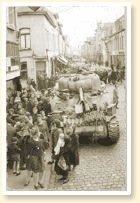

Sherman tank on a festive street with crowds. |
The Liberation of the Netherlands, 1944-1945
By September 1944, the Allied armies, advancing from France and
Belgium, had reached the southern boundary of the German-occupied
Netherlands. The first attempt to break into the Netherlands failed.
The First Allied Army dropped by parachute and glider in
an attempt to capture bridges across the Maas and lower Rhine rivers.
American paratroops successfully took the Maas bridges, but the
British 1st , landing near the Rhine bridge at
Arnhem, was all but destroyed by a strong German force.
At this time Antwerp, Belgium, was in Allied hands, but it could
not be used as a port to resupply the advancing armies because the
Germans held the approaches to the port on both banks of the lower
River Scheldt. In October and November, the 3rd Canadian Infantry
cleared the south bank, while 2nd Canadian Infantry
fought along the north bank.
But at tremendous cost. The Germans cut the dykes to let seawater
flood the low-lying fields and the attackers were forced to follow
narrow, fire-swept routes along the tops of dykes or to attempt
amphibious assaults. The Scheldt battles cost the First Canadian
6,367 killed, mostly from among the tired, perpetually wet
infantrymen.
After an uncomfortable winter spent patrolling through the wet
Dutch countryside, the Canadians got the help of their countrymen
from Italy ( see the Sicilian
and Italian Campaigns ), who advanced
quickly north from the Rhine through the eastern Netherlands to
the North Sea. Although the fighting was never easy, and continued
nearly to the last day of the war, the German resistance collapsed
from lack of supplies and manpower. In the western Netherlands,
getting food to the starving Dutch population in their flooded villages
was the major task. Finally, there was a ceasefire, allowing food
to be dropped by parachute or trucked in.
Related Newspaper Articles
English Articles
- An Epic of the War
The Globe and Mail, 28/09/1944
- Canadians Thrust Deeper Into Holland
The Globe and Mail, 03/10/1944
- R.H.L.I Has Lead Role in Capture of Dutch Island
The Hamilton Spectator, 06/11/1944
- Scheldt Cost 40 000; Antwerp Port in Use
The Globe and Mail, 30/11/1944
- 'Water Rats' Catches on a Nickname for Canadian Third Division
in Holland
The Globe and Mail, 06/04/1945
- More than 1,000 German, Dutch Jews Freed by Canadians in Netherlands,
The Hamilton Spectator, 14/04/1945
- Canadians in Holland Trap 110 000 Huns
The Globe and Mail, 19/04/1945
- Food Deal in Holland May End in Surrender, German Officer Hints,
The Globe and Mail, 03/05/1945
- Canadians Find Gallant Dutch Suffering Yet
The Hamilton Spectator, 26/06/1945
- "When They Ask Who Freed Us…"
The Hamilton Spectator, 25/03/1946
French Articles
-
Les troupes britanniques sont entrées en Hollande
Le Devoir, 11/09/1944
-
La frontière hollandaise franchie à deux endroits
Le Devoir, 14/09/1944
-
À la rescousse des parachutistes encerclés à Arnhem
Le Devoir, 21/09/1944
-
Bataille acharnée et confuse autour du pont d'Arnhem. La percée de la ligne Siegfried pas encore exploitée
Le Devoir, 22/09/1944
-
Les parachutistes d'Arnhem auraient été écrasés
Le Devoir, 27/09/1944
-
Les parachutistes d'Arnhem ont forcé l'admiration des Allemand
Le Devoir, 28/09/1944
-
Offensive canadienne au nord du canal Léopold. Pour libérer les bouches de l'Escaut
Le Devoir, 06/10/1944
-
Nouvelle offensive des Canadiens. Au nord d'Anvers...
Le Devoir, 21/10/1944
-
Les Allemands retraitent sur un front de 15 milles
Le Devoir, 25/10/1944
-
Les alliés effectuent un débarquement à l'île Beveland.
Le Devoir, 27/10/1944
-
Les nazis menaces d'encerclement en Hollande. Berg-Zoom tombre aux mains des Alliés
Le Devoir, 28/10/1944
-
"La désagrégation des troupes nazies, dans les Pays-Bas"
Le Devoir, 30/10/1944
-
La Hollande menacée de famine
Le Devoir, 08/11/1944
-
Retraite nazie en Hollande
Le Devoir, 08/11/1944
-
Impressions d'un Canadien en Hollande
Le Devoir, 09/11/1944
-
Le camouflage des aérodromes ennemis
Le Devoir, 14/11/1944
-
Courage admirable des nôtres en Hollande
Le Devoir, 22/11/1944
-
Ravages nazis en Hollande
Le Devoir, 04/12/1944
-
Secours à la Hollande
Le Devoir, 14/12/1944
-
Le Noël de nos gars en Hollande
Le Devoir, 26/12/1944
|